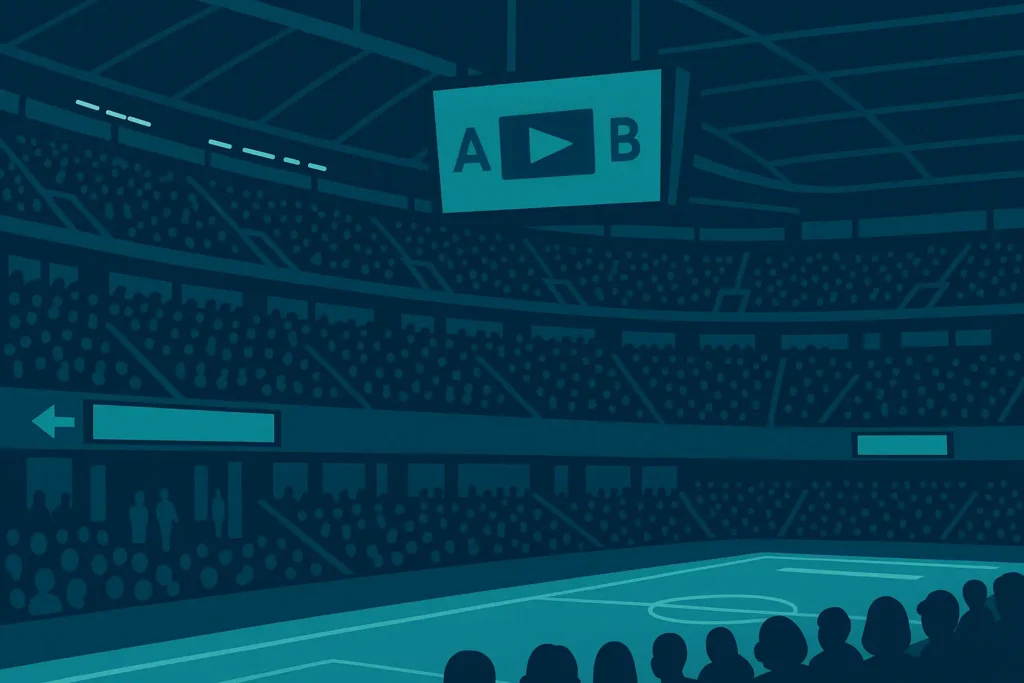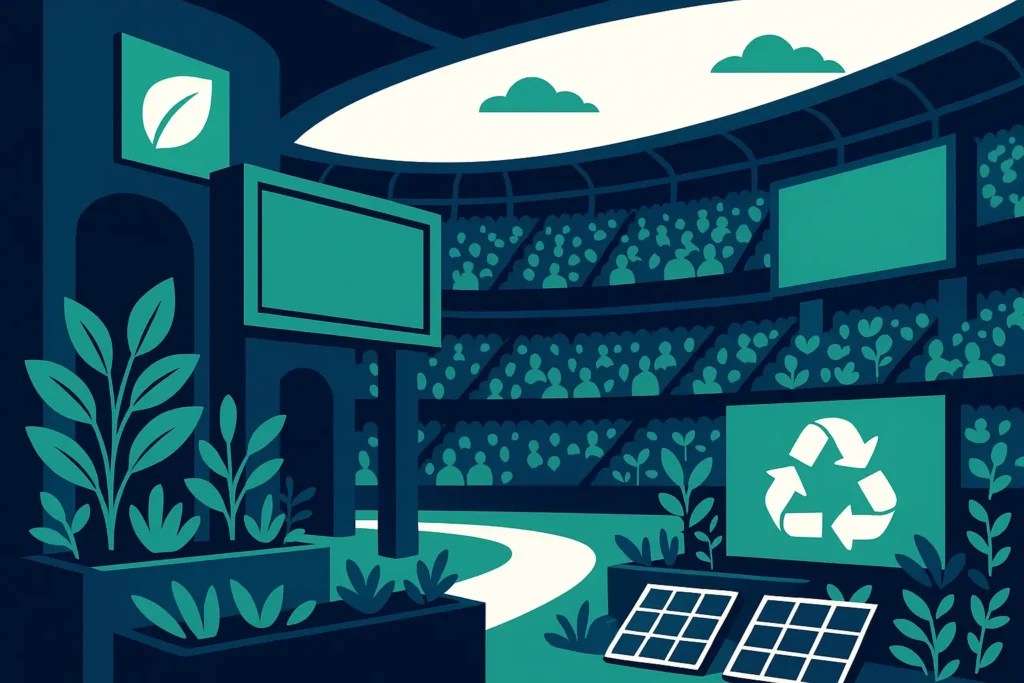Introduction
A stadium is more than a bowl of seats. It is a live media platform, a community landmark and a revenue engine. The right mix of signage and branding turns concourses into experiences, directs fans smoothly from gate to seat, and gives sponsors a stage that feels premium rather than cluttered. This guide explains how to plan, specify and execute stadium signage that stands up to weather, wear and broadcast scrutiny while delivering measurable value.
Pointmedia works with rights holders, venue operators, and event agencies to design, print, and install large-format graphics and event overlays at scale. If you need a sports event signage contractor who can survey, manufacture and install nationally at pace, this guide shows you what good looks like and how to brief it.

What Counts As Stadium Signage and Branding
Stadium branding spans permanent and temporary assets. Permanent items include façade lettering, wayfinding and interior signage, concourse wraps, hospitality décor, safety signs and digital screens. Temporary event overlay includes tournament livery, cup tie takeovers, sponsor activations, freestanding structures and exhibition and events branding. The best programmes link signage types to clear objectives. Typical goals include increasing sponsor recall, reducing congestion, improving accessibility, increasing dwell time in retail zones, and elevating the perceived quality of the venue.
Strategy First: Objectives, Audiences and KPIs
Start with outcomes. Choose one to three primary objectives and map them to zones that move the needle. For example, if reducing entry queues is a priority, emphasise clear, high contrast gate and ticketing signage that is visible from approach routes. If sponsor value is the focus, audit all sightlines that appear on broadcast shots or crowd photos and prioritise those placements.
Define audiences across the whole journey. Home and away fans, hospitality guests, families, wheelchair users, media and staff all have different needs. Track KPIs that reflect the objectives. Useful measures include average time from gate to seat, retail conversion by concession, wayfinding success in fan surveys, QR scans on promotions, and sponsor recall in post-match panels. For digital signage, plan distinct dayparted schedules for matchdays and non-matchdays to optimise relevance.

Stadium Zones and the Best Signage For Each
Exterior approach and façades. Large banners, mesh scrims and illuminated lettering set the tone. Use architectural wraps to hide construction or back-of-house clutter. Mesh banners reduce wind loading on exposed elevations. For durable options that read well at a distance, see Exterior Signage.
Gate entries and ticketing. Oversized numerals, colour-coded zones, and pictograms help fans quickly pick the correct lane. Reinforce rules with plain language and internationally recognised symbols.
Concourse and concessions. Consistent header boards, menu lightboxes, hanging wayfinding and ceiling rafts make decisions easy. Position directional arrows so they are visible over crowds and do not rely on floor graphics alone during busy ingress. Explore materials and finishes that suit these environments in Interior Signage.
Seating bowl and vomitories. Section identifiers must be legible from long distances with simple typography and high contrast. Consider reflective or illuminated elements for night matches.
Pitchside and perimeter. Pitchside boards, LED ribbons and rotating systems carry the highest sponsor value. Maintain strict brand standards so colours read correctly on camera under mixed lighting.
VIP, hospitality and boxes. Use premium finishes such as fabric tension frames, digital wallpaper printing and framed graphics to create a hospitality-grade experience that justifies the ticket price.
Back-of-house, media, and team areas. Wayfinding and compliance signs reduce friction for broadcast crews and staff. Media backdrops should be modular and rapid to rebrand between competitions.
Temporary event overlay. For cups, playoffs and concerts, design a modular kit of parts that can be installed overnight and reused across fixtures. Focus on entrances, bowl takeovers, photo moments and broadcast-visible sightlines. For short lead event programmes, coordinate early with Project Management to protect timelines.
Accessibility and inclusive wayfinding. Provide tactile indicators where appropriate, clear contrast ratios, step-free routing information and consistent iconography. Use plain language alongside symbols.
Creative Principles That Drive Impact
Scale and distance. Size graphics for the longest viewing distance in each zone. Prioritise simple shapes, strong contrast and short messages. Crowded creative can read as visual noise in a busy environment.
Hierarchy and motion. For digital screens, limit content blocks and respect a clear hierarchy. Motion should serve legibility and safety, not distract. Use stills or minimal animation near stairways and egress routes.
Colour accuracy and consistency. Different substrates reflect light differently. Calibrate, proof, and use controlled profiles to ensure sponsor and team colours match across vinyl, fabric, and LEDs.
Sponsor integration. Balance brand takeover with venue identity. A strong master system can carry multiple sponsors without feeling like patchwork. Co-locate partner messages where they make sense to fans, such as concourse retail or digital moments tied to live data.
Materials and Print Options That Work In Stadiums
Stadiums present unique challenges. Moisture, UV, wind, crowd contact and rapid changeovers push materials hard. Here are reliable choices:
- Vinyl and self-adhesives. High-tack for rough surfaces, removable for short-term overlay, and anti-graffiti laminates for durability. Use anti-slip-certified films for floors and stair risers in public areas. Artwork setup tips are in Pointmedia’s Artwork Requirements.
- Mesh and PVC-free banner. Mesh reduces wind loading and is ideal for façades and scaffold wraps. Consider PVC-free options where sustainability targets apply.
- Fabric systems. Silicone edge graphics in aluminium frames create premium, crease-free surfaces and allow quick graphic swaps. Suitable for concourses and hospitality areas.
- Rigid boards. Foamex, Dibond and Correx cover wall panels, hoardings and freestanding structures. Choose thickness based on span and fixings. Use fire-rated substrates in public spaces.
- Digital wallpaper printing. Transforms hospitality suites and premium corridors without heavy construction. Select wipeable, low-VOC, fire-rated products.
- Collateral printing. Menus, inserts and pocket guides can run digitally for short batches or offset for high volumes. Digital printing offers speed and personalisation, while offset printing delivers unit-cost efficiency at scale.
- Finishing. Stitching, welded hems, eyelets, keder and SEG edges improve durability and speed installs. Protective laminates improve UV stability and ease of cleaning.
If you need help choosing between digital and offset for printed collateral, the decision usually comes down to run length, speed and the need for variable content. For technical guidance on substrates and finishing, speak with the team via About Our Printing.
Digital Signage Systems Inside Venues
Digital is now core to the stadium mix. Typical components include LED big screens, ribbon boards, concourse LCDs and outward-facing totems. A robust content management system should support real-time data, scheduled playlists and an emergency override that can push safety messaging to every screen in seconds. Plan for content governance and templates to help day-to-day operators stay on brand. Integrate digital with static so that wayfinding and sponsor messaging feel like one cohesive system.
For accessibility, follow recognised guidance on contrast ratios, text size and motion. Align with Web Content Accessibility Guidelines where relevant to ensure content is readable and considerate for all users.
External references:
- W3C Web Content Accessibility Guidelines overview: https://www.w3.org/WAI/standards-guidelines/wcag/

Compliance, Safety and Accessibility
Your signage plan must pass the test of safety and legal compliance. Key considerations include:
- Site surveys and RAMS. Commission professional surveys to capture accurate dimensions and fixing points. Develop risk assessments and method statements for all installs, particularly those at height or during night work. UK Health and Safety Executive guidance on working at height is a useful reference: https://www.hse.gov.uk/work-at-height/the-law.htm
- Fire performance. Use substrates and finishes with appropriate fire ratings for public areas. Confirm classifications with suppliers and keep certificates on file.
- Slip and impact. For floors and stair graphics, specify films with verified slip ratings. For any projections or low-headroom zones, use protective edging and clear warnings that comply with safety sign standards. ISO 7010 covers safety sign symbols used internationally: https://www.iso.org/standard/56147.html
- Accessibility. Provide tactile and visual cues, step-free routing information and clear pictograms. The UK Government’s accessibility guidance for public sector communications is a practical baseline: https://www.gov.uk/guidance/publishing-accessible-documents
For stadium operations, the Sports Grounds Safety Authority publishes widely referenced guidance for spectator safety planning and signage considerations:
- SGSA “Green Guide” overview: https://sgsa.org.uk/green-guide/
Installation Logistics and Project Management
Strong project management is what separates neat design from smooth delivery. Treat pre-production as non-negotiable. Complete surveys, gather approvals, produce artwork to exact build dimensions and test high-visibility items with prototypes. Plan access routes, equipment and night shifts to avoid clashes with training, hospitality and broadcast windows. On match week, coordinate with venue ops, security, police, broadcasters and sponsor teams to sequence works safely. If you need an experienced lead partner for this phase, Pointmedia offers dedicated Project Management and end-to-end Installation services.
Agree on a transparent change control process. Nothing derails a programme like last-minute creative swaps with untested colour profiles or dimensions. Build a spare stock buffer for critical items and keep a labelled inventory to accelerate replacements. For multi-venue rollouts, kitting, packing and distribution are made simpler through Fulfilment Services.
Sustainability In Stadium Signage
Many rights holders now operate formal sustainability frameworks. You can reduce impact through materials, process and reuse.
- Materials. Consider PVC-free banner and fabric systems with recyclable components. Where PVC is unavoidable, plan responsible end-of-life handling. The UK’s WRAP provides practical guidance on plastics and recycling systems: https://wrap.org.uk/
- Inks and energy. Use low-VOC inks and calibrate digital signage schedules to reduce energy use outside operating hours. ISO 20121 offers a framework for sustainable event management that venues can align with: https://www.iso.org/standard/60821.html
- Reuse and modularity. Design seasonal kits that can be refreshed with smaller changeable elements. Store graphics in protective tubes with clear labelling for redeployment.
Pointmedia’s approach to materials and processes is outlined in the company’s Environmental Policy.

Budgeting: Cost Drivers and Smart Trade-offs
Your budget is shaped by material choice, scale, fixing complexity, access methods, and turnaround speed. Large elevations that need specialist access will cost more than concourse frames that can be reached from the floor. Hire versus buy decisions matter for structures, frames and LED. Buying frames for long-term concourse zones is usually efficient, while hiring a scaffold or truss for one-off concerts keeps capital down. Watch for hidden costs such as overnight security, road closures, pitch protection and broadcast compliance adjustments.
Create a prioritisation matrix. Rate each proposed placement by expected impact, footfall and visibility on broadcast or social. Fund the top tier fully. Use cost-effective substrates for back-of-house or lower-impact zones.
Measuring ROI and Sponsor Value
You can and should measure impact. Blend quantitative and qualitative methods. Crowd analytics can estimate impressions. Short SMS or QR surveys capture wayfinding confidence and sponsor recall. Point-of-sale data shows an uplift in concessions tied to signage-led promotions. For partners, provide a straightforward but credible valuation narrative that links audience, exposure duration and creative quality to outcomes, supported by photos and broadcast stills.
Independent benchmarks and research from recognised organisations help structure your methodology. Nielsen and similar firms publish guidance on sponsorship effectiveness, and sports business media often summarise best practice studies without paywalls. Where possible, align your reporting with metrics your commercial team already uses.
Why Pointmedia
Stadium branding calls for an end-to-end partner who can plan, produce and install quickly without compromising safety or quality. Pointmedia brings:
- Specialist large format production. Colour managed workflows and a wide range of durable substrates for interior and exterior environments.
- Event speed and precision. Rapid surveys, prototyping, and nighttime changeovers delivered by experienced crews with national coverage.
- Cohesive creative execution. Consistent colour and materials across vinyl, fabric, rigid boards and digital content templates.
- Practical sustainability. Guidance on PVC-free options, reuse strategies, and responsible end-of-life.
- Clear reporting. Photo documentation, measurement plans and sponsor-friendly summaries.
If you are planning a season-long programme or a one-off takeover, share your brief and site details so we can propose the right mix of materials and placements. You can start a conversation via Contact or send specifications through the Request a Quote form.



